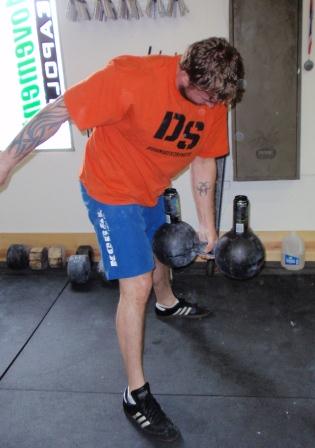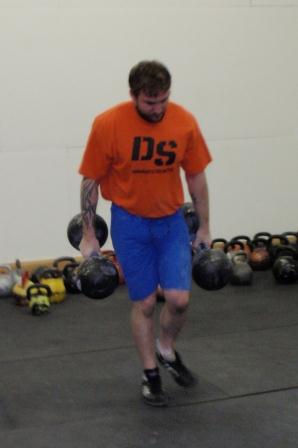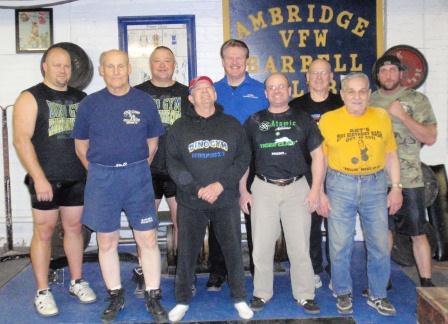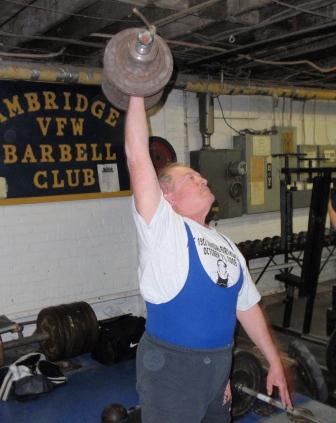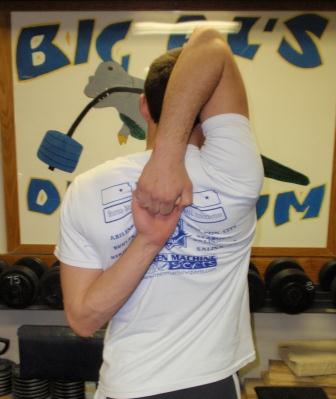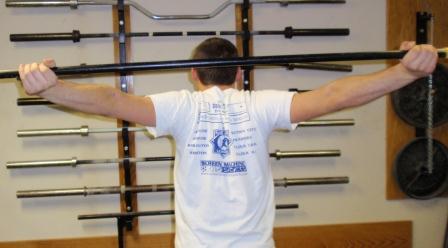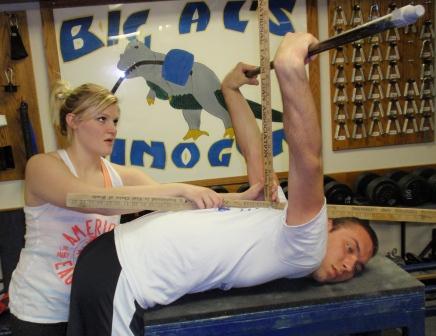Adam Glass and the Inch Dumbbell
by Al Myers
The weekend of the Minnesota All Round Meet I met one of the strongest GRIP GUYS I have ever met. Possibly the strongest. I have seen his FB pictures and YouTube Videos of some of his grip feats beforehand, and was impressed, but nothing is like seeing it firsthand. In fact, I even kidded Adam that I didn’t really believe his UNBELIEVABLE grip lifts until now (and I was just kiddin). Also, I am a hard one to impress with grip feats of strength because I have seen some of the best in action in the Dino Gym before – guys like Andrew Durniat, Ben Edwards, Matt Graham, to name a few. I have an IronMind Inch Dumbbell Replica in the Dino Gym that has been lifted by 5 guys (Matt Graham, John Conners, Matt Vincent, Dave Brown, and Andrew Durniat) so it’s not like I haven’t seen this done before. But the things Adam Glass did with the Inch Dumbbell are things I have NEVER seen before, and I would question if there are very many people in the World who could even replicate these feats of his.
I’ll leave the history and description of the Thomas Inch Dumbbell for another story. I want this story to be about the things I witnessed Adam perform with the Inch Dumbbell. First of all, I want to tell a little bit about him before I start with “the meat” of the story. When I got to The Movement early Saturday morning for the competition he was the only one in the gym at the time. He was tidying things up for the days meet. Very friendly first impression. He didn’t seem built like some of the monster “grip guys” I have meant in the past – taller than me, but not a huge frame like guys like Mark Felix. But I did notice his very long fingers and hands when I shook his hand. Also, he didn’t try to “bad ass” me with his handshake (cause he could if he wanted – he has closed the #3COC gripper!). Just a firm shake and friendly welcome.
The first thing he did was lift the Inch with two cans balanced on top of the globes. I didn’t think there would be a chance that the cans would stay on – but they did! Anyone who has tried to pick up the Inch (which I have over a 100 times with no success) will know that the rotation of the db is the first thing that will get ya. It’s not that the Inch DB is that heavy (It only weighs 172#), but with the thick handle it immediately starts to roll out of your hand. The act of balancing cans on top and STAY tells me that Adam didn’t allow ANY ROTATION. Plus another difficulty with this feat is that you can’t tip the dumbbell to any degree (which does aid in lifting it quite a bit). He lifted it straight up perfectly parallel to the floor, and even held it while I took a picture!!! Lets just say I was impressed with that, but things got even better later on.
Another thing he did is carry two Inch Dumbbells at the same time. I have seen this done before a couple of times, but not after a day of lifting and lifting the Inch numerous times beforehand. He carried the Dumbbells over 30 feet easily – we never measured anything so that is just an estimate. But regardless, I’m sure if he did this “fresh” he could have went much farther.
The last stunt he did with the Inch DB is the one that impressed me the most. He picked up the Inch with his right hand and then let it go and CAUGHT it with his left hand while the dumbbell was in the air!! That may be the most impressive feat I have ever heard of with the Inch DB! I would like to know if anyone else in the World can do that. I didn’t get a picture of that because it happened so fast, but Adam does have YouTube Videos online so you can watch him doing it. I checked the Inch DB he was using and this is the real deal. Not like how old Thomas Inch would pull a “switch a roo” in his exhibitions by having lighter Inch Dumbbells of the same size secretly substituted in and portraying them as the heavy one!
One last thing I want to say about Adam Glass. He is the “total package” when it comes to grip strength. I have seen grip guys who have specialities in which they excel, but Adam is strong at all grip stuff. He a certified Red Nail Bender, as well as an exceptional pinch gripper and round stock lifter (I should mention that he broke Andrew Durniat’s and Ben Edward’s record in the 2″ VB lift). He doesn’t appear to have any weak links in his grip game to me. I am glad to see someone of his caliber become a member of the USAWA!!!
